This is a mixture of my comments and comments pulled from multiple sources (BLS, Cosmopolitan, , Why do Child Labor Laws Matter? Federal laws provide a minimum of protections for child labor. The laws were enacted nearly a century ago in reaction to children being exposed to dangerous activities. Edwin Markham “Child at the Loom.” Cosmopolitan There was a time in this country when young children routinely worked legally. As industry grew in the period following the Civil War, children, often as young as 10 years old but sometimes much younger, labored. They worked not only in industrial settings but also in retail stores, on the streets, on farms, and in home-based industries. “History of child labor in the United States—part 1: little children
Topics:
Angry Bear considers the following as important: Child Labor, EPI, law, politics, US EConomics, US/Global Economics
This could be interesting, too:
Robert Skidelsky writes Lord Skidelsky to ask His Majesty’s Government what is their policy with regard to the Ukraine war following the new policy of the government of the United States of America.
NewDealdemocrat writes JOLTS revisions from Yesterday’s Report
Joel Eissenberg writes No Invading Allies Act
Ken Melvin writes A Developed Taste
This is a mixture of my comments and comments pulled from multiple sources (BLS, Cosmopolitan, , Why do Child Labor Laws Matter? Federal laws provide a minimum of protections for child labor. The laws were enacted nearly a century ago in reaction to children being exposed to dangerous activities.

There was a time in this country when young children routinely worked legally. As industry grew in the period following the Civil War, children, often as young as 10 years old but sometimes much younger, labored. They worked not only in industrial settings but also in retail stores, on the streets, on farms, and in home-based industries. “History of child labor in the United States—part 1: little children working, Monthly Labor Review, (bls.gov)
A September 1906 edition of Cosmopolitan magazine recounts a story telling of an old Native American chieftain visiting New York City. He was given a tour of the modern city of New York. On this excursion, he saw the soaring heights of the grand skyscrapers and the majesty of the Brooklyn Bridge. He observed the comfortable masses gathered in amusement at the circus and the poor huddled in tenements. Upon the completion of the chieftain’s journey, several Christian men asked him,
“What is the most surprising thing you have seen?”
The chieftain replied slowly with three words:
“little children working.”2
Many people on the sidelines assume children working in grueling and/or dangerous jobs is a thing of the past. In fact, violations of child labor laws are on the rise. State lawmakers are attempting to weaken the standards that protect children in the workplace. With a shortage of Labor, it appears some employers are looking the other way as reported in the news. One way to quash this from occurring is to make sure families have a livable income.
~~~~~~~~
“Child labor laws are under attack in states across the country. Amid increasing child labor violations, lawmakers must act to strengthen standards, epi.org, Jennifer Sherer and Nina Mast
At a time when serious child labor violations are on the rise in hazardous meatpacking and manufacturing jobs, several state legislatures are weakening or threatening to weaken child labor protections. The trend reflects a coordinated multi-industry push to expand employer access to low-wage labor and weaken state child labor laws in ways that contradict federal protections, in pursuit of longer-term industry-backed goals to rewrite federal child labor laws and other worker protections for the whole country. Children of families in poverty, and especially Black, brown, and immigrant youth, stand to suffer the most harm from such changes.
Summary of findings
- Both violations of child labor laws and proposals to roll back child labor protections are on the rise across the country. The number of minors employed in violation of child labor laws increased 37% in the last year and at least 10 states introduced or passed laws rolling back child labor protections in the past two years.
- Attempts to weaken state-level child labor standards are part of a coordinated campaign backed by industry groups intent on eventually diluting federal standards that cover the whole country.
- Youth labor force participation declines over the past 20 years reflect that a steadily growing share of young people are choosing to complete high school and obtain additional education in order to increase their long-term employability and earnings. Putting off work in order to obtain more skills and education is a positive trend—for both individuals and the economy—not one that should be slowed or reversed.
- State and federal lawmakers must act to protect and advance the rights of workers of all ages and backgrounds while protecting poor and/or immigrant youth from exploitation. Policy recommendations include raising the minimum wage (and eliminating subminimum wages for youth), ending the two-tiered system of standards for agricultural and nonagricultural work, enforcing wage and hour laws, passing key immigration reforms, and supporting workers’ right to organize and form unions.
In February 2023 the U.S. Department of Labor (DOL) issued new findings on an ongoing investigation of Packers Sanitation Services, Inc. (PSSI) for illegally employing over 100 children between the ages of 13 and 17 in hazardous occupations at 13 meatpacking facilities owned by JBS, Cargill, Tyson, and others (DOL 2023).
~~~~~~~~
‘It’s just crazy’: Republicans attack US child labor laws as violations rise, The Guardian
History of child labor in the United States—part 1: little children working, Monthly Labor Review, U.S. Bureau of Labor Statistics (bls.gov).
History of child labor in the United States—part 2: the reform movement, Monthly Labor Review, U.S. Bureau of Labor Statistics (bls.gov)
Economics, the Realm of Money and the Significance of GDP Growth, with an Application to Child Labor, Angry Bear, Peter Dorman

